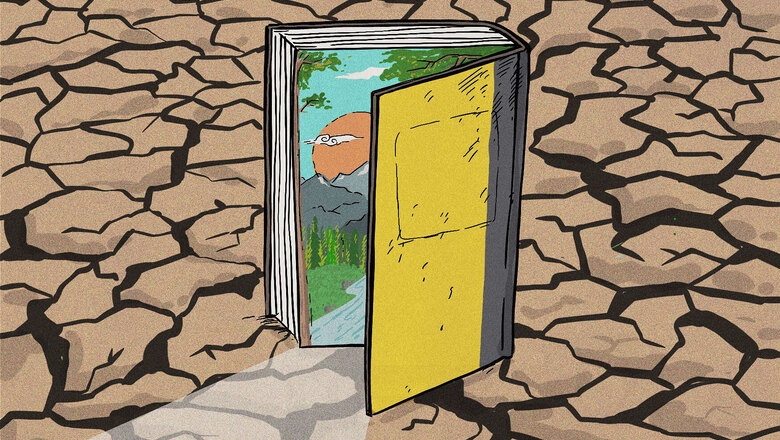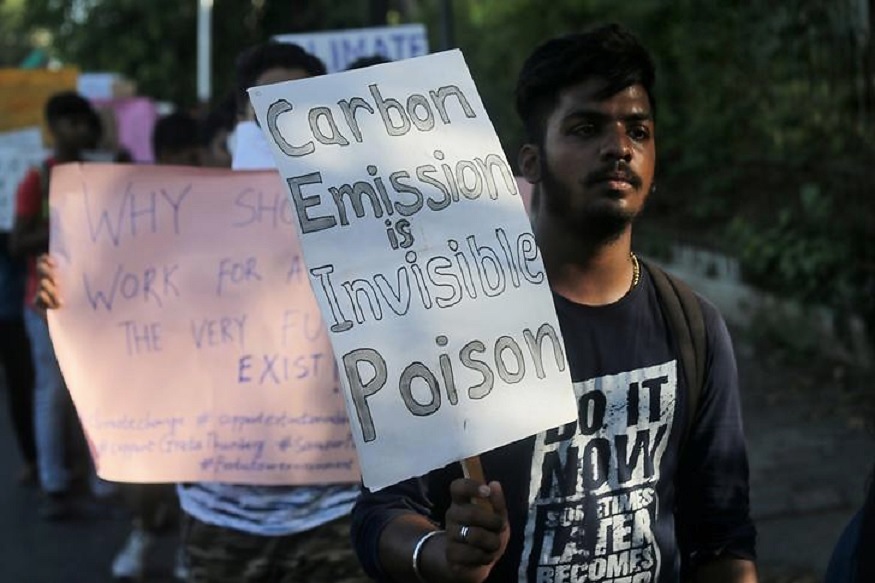
views
According to a paper by Brandi S. Morris et al, titled 'Stories vs facts: triggering emotion and action-taking on climate change' published in Climatic Change Journal (2019), "narratives framed as stories consistently outperformed factual narratives for encouraging action-taking in all audiences (against climate change)."
However, in the past few decades, all our stories about climate change - in books, films, photographs and media - have failed to transform social apathy towards climate change into urgent actions to tackle it.
Show the right picture
At a recent panel discussion on climate change organised by Paper Planes, titled ‘Oddly Enough’, Bijal Vachharajani, children’s books author and senior editor of Pratham Books, pointed out the most obvious error of climate change storytellers.
“The central imagery used while discussing climate change is mostly a polar bear, or the ice caps melting at the Artic. So, the first thought that strikes you is that this doesn’t impact you,” said Vachharajani.
Conveying the seriousness of the issue is also a matter of lexicon. The approach in popular culture until now has been to show extreme scenarios of climate change, ‘the gloom and doom’ as researchers would put it.
“When you show messages of gloom and doom, people switch off and go into denial. That's one of the biggest problems with climate change narratives so far, that people have switched off because they think that they cannot do anything about it anyway. So, they feel they might as well be in it for the car crash.”
It isn't only about imagery though. Photojournalist Arko Dutta pointed out that even photographic evidence of real disasters caused by climate change doesn't convey the seriousness of the issue.
Dutta, who has documented the terrifying plight of humans due to climate change for years, said, "Majority of the people don't act when they see visuals of natural disasters caused by climate change because they view these narratives as outsiders, as tourists."
The way a group of people are exposed to climate change stories play a pivotal part in framing their reactions, said the photographer. "For instance, my friends and family came forward to help a few families in Sundarbans after cyclone Fani. They trust me and know I have been working in that region - so when they saw photographs and read the news about the cyclone, they could relate to those affected," he added.
Where are the books and storytellers?
Literature, too, has failed to address climate change. Books on climate change written by Indian authors are rare and mostly non-fiction like The Great Derangement, Handbook of Climate Change and India: Development, Politics and Governance, The Great Smog of India etcetera. Unfortunately, non-fiction isn't a genre that many read.
The landscape of climate change fiction is bleak too. The few books that do come out are cloaked as dystopias - of a waterless future, or a post-apocalyptic world - which barely register in people's brains as real possible scenarios. These books are instantly relegated to the genre of science fiction.

A participant holds a placard as he takes part in a protest march demanding urgent measures to combat climate change, in Mumbai. (Photo: Reuters)
The case of missing books is worse in vernacular languages. A few months ago, publisher Pratham Books, along with CGNet Swara, a platform to discuss issues related to the Central Gondwana region, brought village youngsters together to translate some of their digital books into Gondi. The Gondi versions were then spiral bound into books and given to the village kids for free, who for the first time read about climate change, that too in their own language.
However, efforts such as these are, unfortunately, few and far between.
In India, climate change narratives had been exclusionary so far. None of the expensive books in English that talk about climate change are available to the vast majority of Indians who neither speak the language nor have the financial capacity to purchase such books to educate themselves.
What is required now are community storytellers to sensitise farmers, women and other marginalised members of the society who are most vulnerable to climate change.
Behind the screens
Yet another challenge is the visualisation element of climate change. How exactly does one show sea-level rise, carbon emissions and temperature change in movies? So far, Bollywood has made a few movies on natural calamities - Mother India (1957), Waqt (1965), Kai Po Che (2013) and Kedarnath (2018), but there is practically no film that connects the dots to climate change apart from Kadvi Hawa (2017), directed by Nila Madhab Panda.
"Making a film on climate change in India is hard. It requires characters you care about, it needs a script that is well-informed about the scientificity of climate change. Also, the makers are generally scared if people would understand the stories or if it would make money," Panda told News18.
What we forget is climate change leaves its mark, not just on landscapes but on the human psyche, pointed out the filmmaker. "It has a profound impact on human emotions. In Mumbai, when it rains, many people manifest emotional changes. My film, Kadvi Hawa shows exactly what the impact is of climate change on human relationships, and emotions," he added.
Panda's claim to fame was a documentary titled Climate's First Orphans about 20,000 environmental refugees who lost their homes, and villages to the ingressing sea. The villages in Odisha where the filmmaker shot the film no longer exist, they have been gulped down by the sea.
"My objective to make a film on climate change is not entertainment alone. It should impact you, it should demand action," said Panda.
The Media Report
Three out of 13 environmental journalists killed since 2009 were Indians - Sai Reddy, Jagendra Singh and Karun Misra. While this makes India one of the most dangerous places for environmental journalists, more news outlets now have an environment beat, which means coverage of climate change-related news coverage is growing.
"The problem, however, is that there is no consistency in coverage," pointed out Bangalore-based independent environment journalist, Sibi Arasu. "Connecting natural disasters and extreme weather to climate change rarely happen in regular reports...Also, the media really needs to highlight the ecological consequences of the government's developmental policies, which, many times are harmful," he added.
It is hard to report on environment law violations because most of the time the journalists are up against corporates with deep pockets. "Unfortunately, if you belong to the regional media, and you do not have the clout that many in the cities and English media enjoy, you are more a target of such forces," said the journalist.
Despite the risks, more and more Indian journalists are reporting on the environment, although, they have had little success in changing public’s mindset. Counselling psychologist Natasha Mehta believes that the change in mindsets can only happen with an 'I am responsible' approach.
"What should be explained is that the carbon footprint is an individual one before it becomes a national one," said Mehta. Therefore, if the overarching narrative depicts climate change as an impossible-to-fix problem or matters for politicians and governments to deal with, it will never engage readers. "The conversation has to be solution-driven," she added.
Communicating government policies
In 2019, for the first time, climate change found a place in the manifestos of both the BJP and the Congress. While political will to address climate change was a step in the right direction, in recent times, we have also seen several governmental policies crash land. Hidden at the root of such policy failures are massive communication blunders.
Navroz Dubash, a professor at the Centre For Policy Research gives an example of how the BRT (bus rapid transport) in Delhi did not work because of the lack of social marketing. "The BRT (bus rapid transport) in Delhi was an interesting case, where the aim was to change behaviour entirely through hardware change. But, the government did no social marketing around it," Dubash said.
"The failure of BRT was later blamed on a flawed design although there was nothing particularly wrong with the design," he added.
Another classic example of communication collapse was the plastic ban in Mumbai. "What was required in this case was behavioural change. But in India, the common approach is that we have to enforce these things (bring about normative change). That is not feasible in any country, particularly in a country where the compliance structure is so weak," the professor said.
The professor argued that the public was not even informed about the basic things regarding the ban like on what plastics the ban had been implemented or why the ban was necessary.
"Dealing with the political economy is also important during these changes. ‘What do you do with those who were employed in plastic factories?' are options that need to be considered," he added.
Corporates Don't Communicate, They Promote
Climate change should not be viewed as a crisis situation for the economy, but as an opportunity for the government to build an improved economy based on green and sustainable practices. Corporates know that, and therefore, 'green brands' have become their newest buzz word.
But, please note that there is one important part of brand communication that every company leave out of their promotional spiel: Just because something is sustainable doesn't mean you should buy it. "We have to balance buying sustainable things with the need to buy," said Janjri Jasani, head of Carbon Map, and Sustainability Services, at Centre For Environmental Research & Education.
"If you buy something that you don't need, you still negatively impact the environment. Marketing something as greener is a way of making the older product seem useless. Of course, when you have to make choices, make a sustainable one. But don't make a choice to buy just because it is sustainable," she added.
In his book, The Great Derangement, Amitav Ghosh pointed out that if we don't explore climate change through tools of culture - like books and movies, then our future generations will conclude that "ours was a time when most forms of art and literature were drawn into concealment that prevented people from recognizing the realities of our plight".
Perhaps, he is right.
This story is part of Covering Climate Now, a global collaboration of more than 250 news outlets to strengthen coverage of the climate story.




















Comments
0 comment